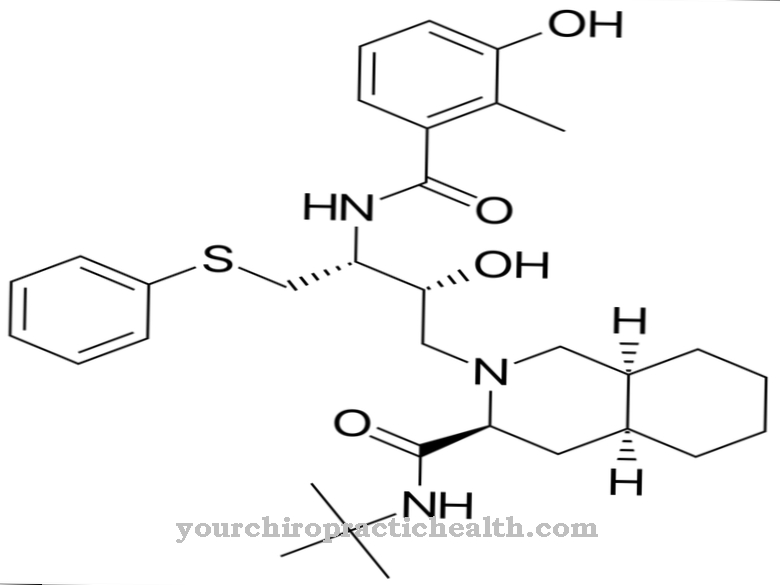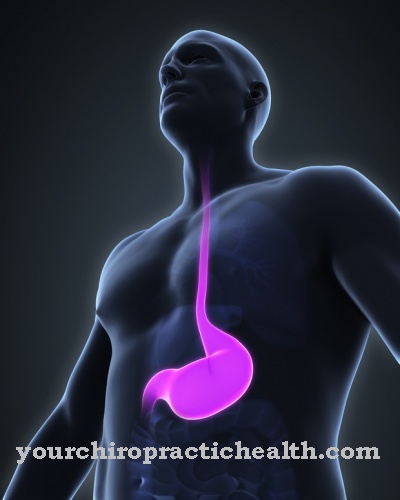At Zalcitabine it is a so-called virostatic for oral intake. It is assigned to the active substance group of nucleoside reverse transcriptase inhibitors (NRTIs) and is used in the antiviral therapy of HIV infections.
What is Zalcitabine?
Zalcitabine belongs to the group of active substances of the NRTI, which are antiretroviral substances. It was first made by Jerome Horwitz in the 1960s in connection with cancer research. A further development as a drug for the treatment of HI viruses was later carried out by the American cancer research center NCI.
In 1992 it was approved for monotherapy, and in 1996 also for combination therapy. As of December 31, 2006, sales in Germany were discontinued due to the introduction of newer forms of therapy. Patients with HIV type 1 were treated with zalcitabine.
From a structural point of view, it is a derivative, i.e. a modified chemical compound of the nucleoside cytidine. Zalcitabine is also an analogue of deoxycytidine. Zalcitabine is a white, crystalline powder which is soluble in water.
Pharmacological effect on the body and organs
Zalcitabine was marketed in the form of tablets. After ingestion and absorption, the drug is converted into the pharmacologically effective 5'-triphosphate. Following the conversion, it is incorporated into the viral genome. Since the hydroxyl group is missing in the active substance molecule, the DNA synthesis of the HI viruses is immediately stopped.
Zalcitabine is almost exclusively transported freely in the blood; it is not bound to plasma proteins. The half-life of zalcitabine is around two hours and its biological value is 80 percent. However, the body only uses around 30 percent of the active ingredient ingested, while the rest is excreted in unchanged form via the kidneys - i.e. via the kidneys.
Medical application & use for treatment & prevention
Until the end of 2006, zalcitabine was used as part of combination therapy in patients with the type 1 HIV virus. During the infection, the HI viruses multiply in the cells of the body. The viruses thus newly formed are finally released and spread throughout the body. This leads to the infection of other cells, and the disease spreads to uninfected cells. Zalcitabine uses an enzyme to ensure that no new DNA from the virus can form.
Until it was discontinued, zalcitabine was considered an alternative for patients who did not tolerate zidovudine or for whom treatment with it was ineffective. In these patients, zalcitabine had the same effect as didanosine. For zalcitabine, as for all other drugs available for HIV patients, it is not possible to cure the infection. Only the progression of the disease can be delayed.
Risks & side effects
Zalcitabine can cause side effects. These express themselves in different ways from patient to patient. Typical side effects of the virostat are primarily headache, diarrhea, constipation, nausea, loss of appetite, a change in the percentage of body fat, itching or fatigue.
A doctor must be consulted immediately if zalcitabine causes side effects such as severe allergic reactions (e.g. difficulty breathing, swelling in the mouth, face or lips, hives), cramps, feeling cold, heart problems (e.g. to fast or slow heartbeat), drowsiness and dizziness, inflammation of the liver, numbness or pain in the limbs (arms, legs, hands, feet), ulcers in the mouth and throat, severe nausea and vomiting or severe difficulty swallowing.
Side effects such as fever, bone and joint pain and neuropathies (diseases of the peripheral nervous system) have also occurred during treatment with zalcitabine.
In order to avoid interactions, drugs should not be taken whose active ingredients can lead to neuropathies. If you take lamivudine at the same time, the effect of zalcitabine is inhibited.
The use of zalcitabine is not indicated for existing diseases of the liver, known diseases of the peripheral nervous system and hypersensitivity to the active ingredient. During the treatment, the doctor must regularly check the patient's blood count. This also applied to patients with existing pancreatitis as well as to patients with increased alcohol consumption.













.jpg)

.jpg)
.jpg)











.jpg)